We spent one day walking around this area (called the “old city”) visiting a few of the innumerable wats – Buddhist temples. They are all ornate, beautiful, ancient and fascinating, and all very similar to one another as well and one can only be impressed by elegantly carved teak wood balustrades and golden Buddha imagines for so long.
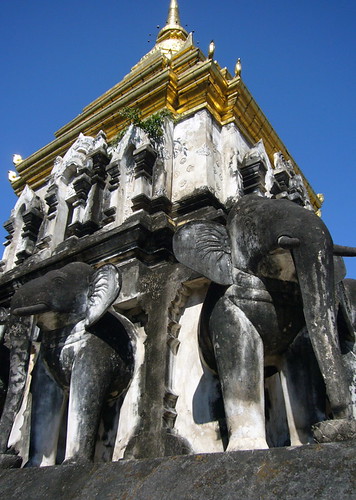
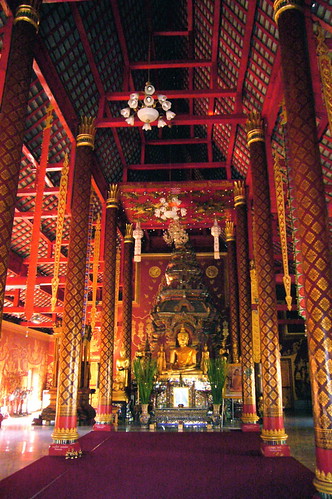

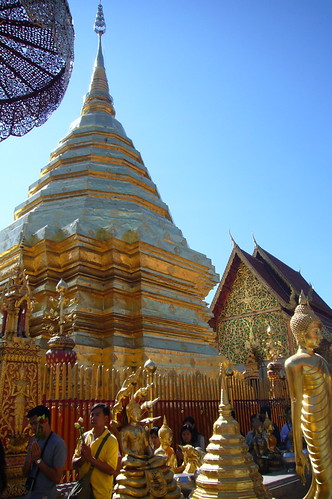
Chiang Mai is heavily visited by tourists, and this becomes even more apparent as evening sets in and temperatures become cool and pleasant and hordes of Western tourists (some from the U.S. but most from Australia and Europe) roam the streets, restaurants, bars and night markets.
We witnessed several examples of a particular species of Western tourist – the middle-aged Caucasian male accompanied by one or several young Thai girls in the bars and pool halls. These are indicative of one of the more tragic elements of the Thai economy – many of these girls come from very poor villages in the hills of the north and eastern parts of the country. They can make relatively good money to support themselves and their families in the city brothels and thus many willfully, and possibly even enthusiastically, engage in this form of economic and sexual slavery.
I find the psychology of the aged men who hire out these women for sex repugnant as well as fascinating. Witnessing the transactions that occur openly in the bars as the men “shop” for a girl for the evening are eerie and leave one’s conscience feeling somewhat soiled.
As long as I’m discussing things that can put one out of one’s mind, I must also mention the street traffic and the markets.
Traveling the streets by foot or motor vehicle represents the nearest example I can imagine to a chaotic, intensely competitive free-for-all. The main vehicles about are minibuses, a few private cars, delivery trucks, an assortment of types of taxis -- familiar small sedans made by Nissan and Toyota, “song-taos” or pickups with covered beds and two rows of bench seats for passengers, and "tuk tuks" or three-wheeled motorized rickshaws -- and an astounding proliferation of mopeds and small engine motorbikes. Almost all vehicles are diesel or two-stroke gasoline engines, which means (1) noisy and (2) smelly pollution.
There are not so much traffic laws here as traffic suggestions, officially recommending to drive on the left while the practical reality is to drive wherever-and-however-the-fuck-one-pleases. And, apparently, there is no legal limit to how many passengers or what type, size, or amount of goods can be transported by motorbike. I have seen families of three carrying groceries, building materials, bags of laundry, bits of furniture, etc. splitting lanes and dodging delivery trucks on pitifully belabored 90 cc Honda scooters.
This all may seem a recipe for disaster however I have yet to witness a collision. Somehow it all seems to “work” in a chaotic but organic fashion. From the pedestrian’s perspective, crossing the street is reminiscent of the old Atari video game Frogger – you have to pick your spot, set your timing, square your jaw, and proceed across the noisy, dusty, smelly buzzing fray of mopeds and larger vehicles with the “unbending intent” of the warrior described in Castenada’s The Teachings of Don Juan.
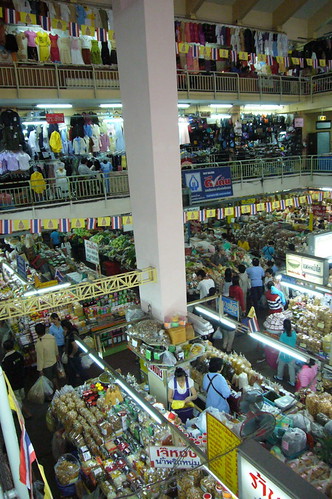
And if the continual onslaught of traffic isn’t enough to unravel one’s nervous system, there are the markets. Any time of day or night one can engage in the voracious melee of commerce. The photo above is of one of the lesser day markets and doesn't really give a sense of the pandemonium that these environments conjure up.
All manner of goods are bought and sold in the markets:
from foods – produce, meats and snack foods -- of discernable and unknown origin;
to clothing – t-shirts with every logo and brand image, tailor-made suits, silk and high-fashion goods, as well as an array of cotton hippie clothes (what middle-class Western hippie kids think rural Thai people wear), work clothes, uniforms, pajamas…;
to weapons, ancient as well as modern – long knives, swords, brass knuckles, Beth even saw a stand on the street corner selling handguns (!);
to every possible thing that can be made from bamboo – these products are countless in variety, form and function;
to all manner of knick-knacks, keepsakes, souvenirs, home decorations, Buddha images of all shapes, postures, sizes, and materials from wood and bamboo to stone to brass, gold, silver;
to electronic goods and sports equipment and a thousand other categories of items great and small, cheap and expensive, useful and decorative…
In sum, the markets are a shopper’s paradise and a mild form of torture for me. Wandering the Chiang Mai night market reminds me of the Las Vegas casinos – another environment constructed with the sole purpose of separating the tourist from his or her money.
OK, so far I have discussed the crowding, the noise, the pollution, the sex trade, the chaotic and dangerous street traffic, and those ungodly shrines for worshipping mammon and commerce called “markets.” From this one might assume that life in Thailand is a veritable hell. Well, it’s only sort-of hell. There are aspects that are actually quite nice. It just turns out that the cities and tourist areas lack most of these aspects.
To get a brief respite from the insanity and chaos, one day Beth and I rented an off-road motorbike and headed up towards the summit of Doi Suthep, the large mountain overlooking the city. Near the top we visited a famous and exquisite wat, and continued up to the end of the road where we hiked the nature trail to the summit. In keeping with our earlier experience the nature trail was deserted, although the wat and palace areas just a few kilometers away were sacked with tourists. Here’s a photo of Beth near the summit overlooking a Hmong hill tribe village.
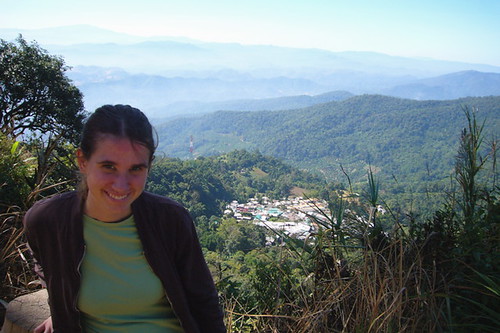


1 comment:
Loved the discription of the traffic. Some of the most fun I've had in Thailand is sitting on the back of a scooter driving in Bangkok traffic.
Post a Comment